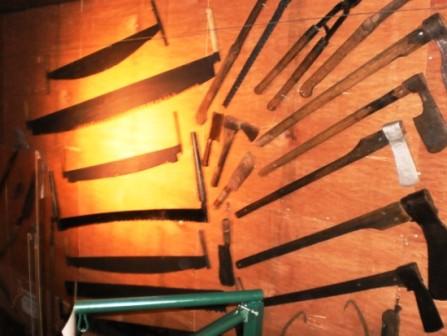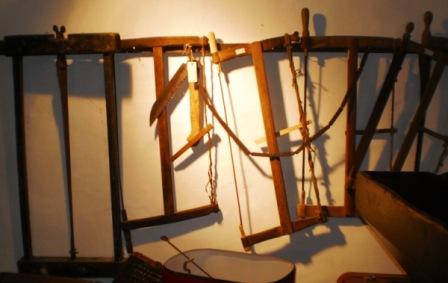 A saw is a thin and flat, usually metal tool with teeth to scrape out grooves of softer materials (wood, stone, metal...). Blade can be flat, but also ribbon-shaped, bell - or circular. For harder materials, the teeth are usually smaller. The teeth are set: alternating even teeth tuned to the left, odd teeth bent just right. (Sometimes only one side.) For this purpose there are special pliers whose angle can be adjusted, so that it is always the same. The teeth should be so wide apart that the saw cannot get stuck in the material to be cut. For still 'working' green wood this is wider than for dry material. They are not so wide open that there is a gap between the left and right, the cut surfaces of the teeth should be overlap.
A saw is a thin and flat, usually metal tool with teeth to scrape out grooves of softer materials (wood, stone, metal...). Blade can be flat, but also ribbon-shaped, bell - or circular. For harder materials, the teeth are usually smaller. The teeth are set: alternating even teeth tuned to the left, odd teeth bent just right. (Sometimes only one side.) For this purpose there are special pliers whose angle can be adjusted, so that it is always the same. The teeth should be so wide apart that the saw cannot get stuck in the material to be cut. For still 'working' green wood this is wider than for dry material. They are not so wide open that there is a gap between the left and right, the cut surfaces of the teeth should be overlap.
The teeth themselves are all filed sharp at the same angle for both the pushing as for the pulling direction.
The first primitive saws used in the Stone Age were probably animal jaws.
Wire saws are centuries old.
Spanish conquistadors saw in Costa Rica to their amazement that natives quickly sawed through a steel sword. The wire saw was a bamboo fiber covered with resin breaded with hard rubble. Also in the Amazon jungle Indians managed that way to make two axes from one steel one.
Wooden frame saw
 A thin metal blade often has too little rigidity in order to be of practical use. It will then be biased into an arch or bow. This used to be a wooden slatted structure in H - shape. The parts were somewhat hinging. The saw was put down between to ends. At the top was a loop tensed around the two styles. In the middle there was between those two ropes a slat, which came to just over the crossbar of the H. By revolving that around the rope and twisting, came with every stroke more tension on the blade. The ruler was detained by the torsion of the ropes against the crossbar of the H. Simple and efficient technique.
A thin metal blade often has too little rigidity in order to be of practical use. It will then be biased into an arch or bow. This used to be a wooden slatted structure in H - shape. The parts were somewhat hinging. The saw was put down between to ends. At the top was a loop tensed around the two styles. In the middle there was between those two ropes a slat, which came to just over the crossbar of the H. By revolving that around the rope and twisting, came with every stroke more tension on the blade. The ruler was detained by the torsion of the ropes against the crossbar of the H. Simple and efficient technique.
Seven women at a round table, a circular saw.
Stone saws
In the palace of Tyrins (Greeks Samarkand) has been found a copper blade with 1.6 mm long teeth of amril, to saw soft stone.
(according to “The surprising knowledge of our ancestors,” William Sander Mann).
Marble was cut by the Romans with iron sheets and sand. In Turkey it happened with silk thread and sand.
Copper saws would be used for construction projects in ancient Egypt with abrasive quartz sand to cut granite. (Denys A. article “Ancient Egyptian Granite - Working Methods in Aswan, Upper Egypt ' in the journal Antiquity). In his experiments, workmen needed 14 hours to cut a slot of 3 cm deep and 95 cm long while the blade was 7.5 mm worn.
(see also <Stone (work)>)
